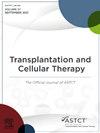Out-of-Pocket Expenditures and Financial Hardship Among Patients With Myelodysplastic Syndrome Undergoing Allogeneic Transplant or Hypomethylating Agent / Supportive Care (BMT CTN 1102)
IF 3.6
3区 医学
Q2 HEMATOLOGY
引用次数: 0
Abstract
Introduction
The Blood and Marrow Transplant Clinical Trials Network (BMT CTN) 1102 trial demonstrated that allogeneic hematopoietic cell transplantation (HCT) was associated with superior overall survival compared to non-HCT approaches among elderly patients with higher-risk myelodysplastic syndrome (MDS). The trial included an ancillary cost diary component to assess the out-of-pocket (OOP) expenditures and financial hardship in the post-HCT period through 3 phased surveys for up to 19 months after enrollment.
Objective
The purpose of the study is to assess the OOP costs and financial hardship experienced by participants of BMT CTN 1102.
Study Design
BMT CTN 1102 assigned participants to Donor and No-Donor arms based on donor availability. Participants could additionally enroll in the ancillary cost diary component, with a total of 138 participants returning 267 surveys across 3 survey waves at 1-, 7-, and 19-months after enrollment. As participants who underwent HCT returned 78% (207/267) of the total surveys, we report on the collected data descriptively.
Results
Participants who underwent HCT had high levels of monthly OOP expenditure ($1126, $812, $442) and financial hardship (47%, 53%, 57%) across the 3 survey waves. For reference, participants who did not undergo HCT generally reported lower levels of OOP expenditure ($478, $845, $256) and financial hardship (37%, 55%, 46%).
Conclusion
Among BMT CTN 1102 participants, those who underwent HCT reported high levels of OOP expenditures and financial hardship for up to 19 months after enrollment. Ongoing routine assessment of patient-level OOP expenditures and financial burden may be helpful in the post-HCT survivorship period.
接受同种异体移植或低甲基化药物/支持治疗(BMT CTN 1102)的骨髓增生异常综合征患者的自费支出和经济困难
血液和骨髓移植临床试验网络(BMT CTN) 1102试验表明,在高风险骨髓增生异常综合征(MDS)的老年患者中,与非HCT方法相比,同种异体造血细胞移植(HCT)与更高的总生存率相关。该试验包括一个辅助成本日记部分,通过入组后长达19个月的三个阶段调查,评估hct后的自费(OOP)支出和经济困难。目的:本研究的目的是评估BMT ctn1102的参与者所经历的OOP成本和经济困难。研究设计:BMT CTN 1102根据供体的可用性将参与者分配到供体组和非供体组。参与者可以额外参加辅助成本日记部分,在入组后1个月、7个月和19个月,共有138名参与者在三次调查中返回267份调查。由于接受HCT的参与者返回了总调查的78%(207/267),我们对收集到的数据进行了描述性报告。结果:在三次调查中,接受HCT的参与者每月OOP支出(1126美元,812美元,442美元)和经济困难(47%,53%,57%)水平较高。作为参考,未接受HCT的参与者通常报告较低的OOP支出水平(478美元,845美元,256美元)和经济困难(37%,55%,46%)。结论:在BMT CTN 1102参与者中,那些接受HCT的人在入组后的19个月内报告了高水平的OOP支出和经济困难。持续的常规评估患者水平的OOP支出和经济负担可能有助于hct后的生存期。
本文章由计算机程序翻译,如有差异,请以英文原文为准。
求助全文
约1分钟内获得全文
求助全文
来源期刊

Transplantation and Cellular Therapy
Medicine-Hematology
CiteScore
7.00
自引率
15.60%
发文量
1061
审稿时长
51 days
 求助内容:
求助内容: 应助结果提醒方式:
应助结果提醒方式:


